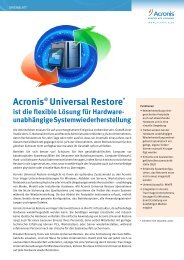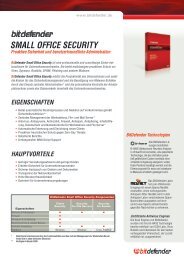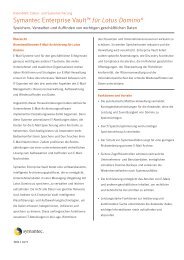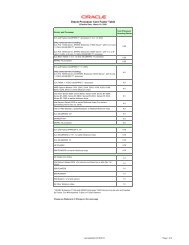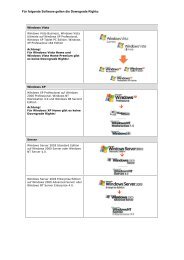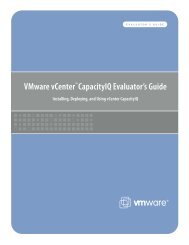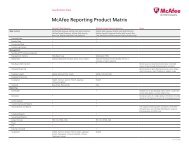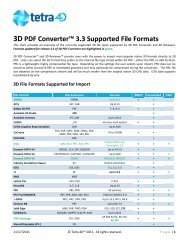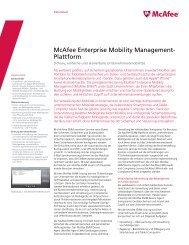A Closer Look at the RamSan-710
A Closer Look at the RamSan-710
A Closer Look at the RamSan-710
You also want an ePaper? Increase the reach of your titles
YUMPU automatically turns print PDFs into web optimized ePapers that Google loves.
Reliability<br />
Some people believe th<strong>at</strong> Flash-based SSD is not ready for <strong>the</strong> enterprise, partly due<br />
to issues of d<strong>at</strong>a reliability. In <strong>the</strong> case of <strong>RamSan</strong> products, this simply is not true.<br />
But it is true th<strong>at</strong> Flash, as a storage medium, presents certain challenges for storage<br />
engineers.<br />
The storage medium in <strong>the</strong> <strong>RamSan</strong>-<strong>710</strong> is Single Level Cell (SLC) NAND Flash. SLC<br />
NAND Flash is a requirement for enterprise applic<strong>at</strong>ions where <strong>the</strong>re is any kind of<br />
mixed read-write workload and heavy sustained use. Some SSD vendors have<br />
experimented recently with Multi-Level Cell (MLC) NAND Flash chips. But MLC is<br />
slower and offers only 10% of <strong>the</strong> reliability of SLC. From <strong>the</strong> TMS perspective, use<br />
MLC in mixed workload enterprise environments <strong>at</strong> your own risk.<br />
In order to meet enterprise reliability requirements, <strong>the</strong> <strong>RamSan</strong>-<strong>710</strong> includes many<br />
key reliability fe<strong>at</strong>ures in its FTF cards:<br />
Three Layers of Flash Memory Protection<br />
Layer 1: ECC for Flash Memory<br />
A proprietary Error Correction Code (ECC) implement<strong>at</strong>ion corrects additional<br />
random bit errors within each 512-byte d<strong>at</strong>a set, a significant increase over <strong>the</strong> bits<br />
required by <strong>the</strong> Flash memory manufacturer.<br />
An additional cyclic redundancy check (CRC) adds additional d<strong>at</strong>a protection by<br />
valid<strong>at</strong>ing each d<strong>at</strong>a set after error correction has been performed.<br />
Layer 2: Variable Stripe RAID for Flash Memory<br />
Variable Stripe RAID (VSR) is a p<strong>at</strong>ented technology from Texas Memory Systems<br />
th<strong>at</strong> reduces <strong>the</strong> risk of uncorrectable errors in user d<strong>at</strong>a while preserving as much<br />
storage space as possible. VSR maximizes chip storage space since it is not necessary<br />
to reloc<strong>at</strong>e an entire stripe following a failure on <strong>the</strong> chip. For example, if a plane<br />
fails VSR autom<strong>at</strong>ically responds, seamlessly rebuilding and efficiently reloc<strong>at</strong>ing any<br />
stripes th<strong>at</strong> contain <strong>the</strong> plane. By dynamically altering <strong>the</strong> stripe size, VSR can<br />
drastically reduce wasted planes.<br />
Layer 3: Active Spare (system-level) Optional<br />
At <strong>the</strong> system level, <strong>the</strong> <strong>RamSan</strong>-<strong>710</strong> allows you to design<strong>at</strong>e one of <strong>the</strong> cards inside<br />
<strong>the</strong> system as an active-spare th<strong>at</strong> works hand-in-hand with <strong>the</strong> chip level RAID on<br />
each of our boards. If one of <strong>the</strong> cards experiences a failure th<strong>at</strong> degrades its RAID<br />
protection, <strong>the</strong> system will immedi<strong>at</strong>ely migr<strong>at</strong>e <strong>the</strong> d<strong>at</strong>a on th<strong>at</strong> card to <strong>the</strong> Active<br />
Spare to return to a fully redundant st<strong>at</strong>e. At th<strong>at</strong> point, <strong>the</strong> failed card will be<br />
inactive and can be swapped during <strong>the</strong> next scheduled maintenance downtime.<br />
July 2011 14 Texas Memory Systems






